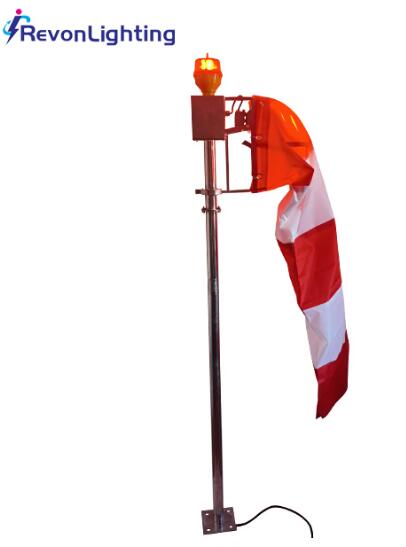Posted: 2024-07-30
In the aviation industry, precision and safety are of utmost importance. Every tool and device employed within an airport or helipad is designed to ensure the secure and efficient operation of aircraft. Among these tools, the aviation windsock and helipad windsock are particularly vital. These simple yet effective devices provide crucial information about wind conditions, enabling pilots to make informed decisions during takeoff, landing, and other flight maneuvers. This article explores the significance, design, and benefits of aviation windsocks and helipad windsocks, underscoring their essential roles in aviation safety.
Aviation Windsock: A Fundamental Tool for Pilots
An aviation windsock, commonly referred to as a windsock, is a device used to indicate wind direction and speed. It is a conical textile tube that is mounted on a pole and rotates freely with the wind. The wider end of the windsock catches the wind, causing the narrow end to point in the direction the wind is blowing. The degree of extension of the windsock indicates the wind speed, with a fully extended windsock representing higher wind speeds.
The primary function of an aviation windsock is to provide real-time visual information about wind conditions. This information is critical for pilots during various phases of flight, especially takeoff and landing. Knowing the wind direction and speed helps pilots determine the appropriate runway to use and how to adjust their approach. It also aids in making decisions about aircraft performance, as wind conditions can significantly affect takeoff and landing distances.
Helipad Windsock: Ensuring Helicopter Safety
A helipad windsock serves a similar purpose to an aviation windsock but is specifically designed for helicopter operations. Helicopters, due to their ability to take off and land vertically, have different operational requirements compared to fixed-wing aircraft. Wind conditions play a crucial role in helicopter performance, affecting hover, approach, and departure maneuvers.

The helipad windsock provides essential wind information to helicopter pilots, helping them determine the safest and most efficient way to approach and depart from a helipad. Accurate wind data is vital for maintaining control during hover and ensuring a stable landing. Helipad windsocks are typically placed in highly visible locations around the helipad, ensuring that pilots can easily see them from the air and ground.
Design and Functionality
The design of an aviation windsock and a helipad windsock is simple but highly effective. Both are made from durable, weather-resistant materials that can withstand various environmental conditions. The conical shape allows the windsock to capture the wind efficiently, and its lightweight construction ensures it responds quickly to changes in wind direction and speed.
Aviation windsocks and helipad windsocks are usually brightly colored, such as orange or white, to enhance visibility. Some windsocks feature stripes for added contrast, making them easier to see from a distance. To ensure visibility during nighttime operations, many windsocks are equipped with lighting, either through internal illumination or external spotlights. This feature is crucial for airports and helipads that operate 24/7.
Benefits of Windsocks
Real-Time Wind Information: Windsocks provide immediate and accurate information about wind direction and speed, which is crucial for safe flight operations. Pilots rely on this data to make informed decisions about their approach, landing, and takeoff.
| Helipad Windsock | ER |
| TR | 45 |
Enhanced Safety: By offering clear visual cues about wind conditions, windsocks significantly enhance aviation safety. Pilots can better understand and react to wind changes, reducing the risk of accidents and improving overall flight performance.
Cost-Effective: Windsocks are relatively inexpensive to install and maintain. Their simple design and durability make them a cost-effective solution for providing essential wind information at airports and helipads.
Versatility: Windsocks are used in a variety of aviation settings, from small private airstrips and helipads to large international airports. Their simplicity and effectiveness make them a universally valuable tool.
Technological Advancements
While the basic design of windsocks has remained consistent over the years, technological advancements have enhanced their functionality. Modern aviation windsocks and helipad windsocks may incorporate sensors that provide digital wind data, which can be transmitted to air traffic control systems and pilot instruments. These sensors offer precise measurements of wind speed and direction, complementing the visual information provided by the windsock.
Additionally, some advanced windsocks are integrated with automated weather observation systems (AWOS) and airport lighting control systems. This integration allows for real-time monitoring and adjustment of windsock lighting and other parameters, improving overall airport and helipad operations.
Challenges and Considerations
Despite their simplicity and effectiveness, windsocks face several challenges. Their accuracy can be affected by surrounding structures or terrain, which may create turbulence and disrupt wind flow. Therefore, careful placement is essential to ensure reliable wind information.
Weather conditions can also impact the performance of windsocks. Heavy rain, snow, or ice can weigh down the fabric, reducing its sensitivity to wind changes. Regular maintenance and inspection are necessary to keep windsocks in optimal condition and ensure they provide accurate readings.
Future Prospects
The future of windsock technology looks promising, with ongoing research and development aimed at enhancing their accuracy and functionality. Innovations such as more durable materials, improved lighting systems, and advanced wind sensors are likely to make windsocks even more reliable and efficient.
Moreover, the integration of windsocks with digital communication systems and other airport and helipad infrastructure will continue to improve their effectiveness. As the aviation industry advances, windsocks will remain a vital component of aviation safety and operations, reflecting their enduring value.
The aviation windsock and helipad windsock are indispensable tools in the aviation industry. They provide crucial real-time wind information that enhances the safety and efficiency of flight operations. Despite their simple design, windsocks play a significant role in ensuring that pilots can make informed decisions based on accurate wind data. As technology continues to evolve, the functionality and reliability of windsocks will only improve, cementing their place as essential components of modern aviation infrastructure.